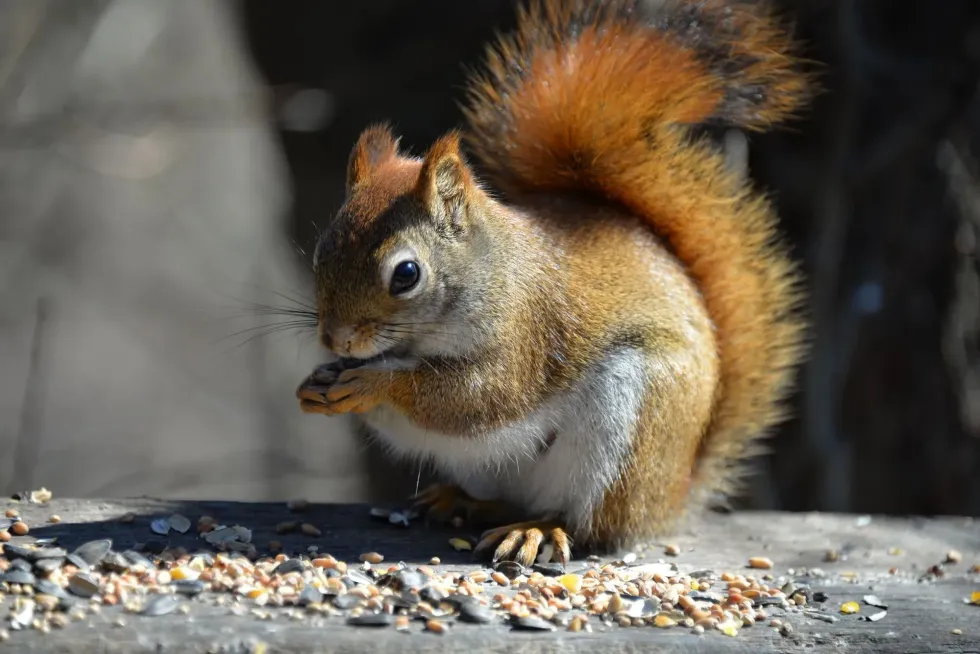The Namdapha flying squirrel is one of 50 unique species of flying squirrels.
Its scientific name is Biswamoyopterus biswasi and it is endemic to the state of Arunachal Pradesh, which is located in north-eastern India. It is a member of the family Sciuridae and is known to dwell in a small range in the eastern Himalayas.
It is an arboreal squirrel and most of the information that is known about it is known from only a single specimen that was collected in 1981 in the Namdapha National Park.
It is endemic to the north-eastern region of India as this nocturnal flying squirrel species is known to inhabit hill slopes of tall Mesua ferrea jungles in the Dihing River's catchment area. The range of this rare squirrel is quite limited and within its range, it faces threats like habitat destruction and poaching for food.
It is the focus of the Global Wildlife Conservation Search for Lost Species initiative along with 25 other 'lost' species.
This species looks very similar to the red giant flying squirrel. However, it can be distinguished from the red giant flying squirrel by observing its pale-gray crown, orangish patagium, white underparts, and its characteristic grizzled reddish fur.
It can attain a length of 15.9 in (40.3 cm) and weighs between the range of 4.4-5.5 lb (2-2.5 kg).
It is herbivorous and feeds upon fruits, flowers, sap, seeds, nuts, and fungi. Keep reading to discover more fascinating facts about the typical Namdapha flying squirrel habitat in the wild, its appearance, conservation efforts, and much more!
If you enjoyed reading our Napmdapha flying squirrel facts, you must check out our amazing related articles like these nutria surprising facts and feathertail glider interesting facts!
Namdapha Flying Squirrel Interesting Facts
What type of animal is a Namdapha flying squirrel?
The Namdapha flying squirrel (Biswamoyopterus biswasi) is a flying squirrel species that lives in north-eastern India. This species was named after the Mesua ferra jungles that border the Noa Dihing River of Arunachal Pradesh in India, the place where this species was discovered.
The region where this species was discovered falls under the range of the Namdapha National Park, India's third-largest national park.
What class of animal does a Namdapha flying squirrel belong to?
The Namdapha flying squirrel (Biswamoyopterus biswasi) is a rare squirrel that belongs to the class Mammalia, the order Rodentia, and the genus Biswamoyopterus. It is one of three species of its genus.
How many Namdapha flying squirrels are there in the world?
There is currently no data regarding the population of these mammals due to a lack of research. As there have not been many appearances of this species since its discovery, it is assumed that it is on the brink of extinction.
However, a significant region of the Namdapha National Park has not yet be explored, which gives scientists reason to believe that this species may be in there, hiding.
Flying squirrels aren't spotted regularly as they have an elusive nature, which could also be the reason why these animals aren't seen regularly. Nature makes it tricky for scientists to track and research about them.
Where does a Namdapha flying squirrel live?
It dwells in a small region of the eastern Himalayas in north-eastern India. It dwells on hill slopes of tall Mesua ferrea jungle regions near the Dihing River, particularly on the Patkai range's western slopes in Arunachal Pradesh.
Just a single specimen of this mammal was collected from India's Namdapha National Park in 1981. This species cannot be found anywhere else in the world. It is endemic to the north-eastern region of India.
What is a Namdapha flying squirrel's habitat?
This wild animal is arboreal and is assumed to be most active after the evening. It is known to dwell in broadleaved temperate forests. A specimen of this species was discovered inhabiting a lofty tree at an altitude of 1148.2 ft (350 m) above sea level.
Who do Namdapha flying squirrels live with?
This flying squirrel species is solitary typically but they are known to nest together in the colder months.
How long does a Namdapha flying squirrel live?
The lifespan of this species is not known due to a lack of research. However, we do know that flying squirrels can have a 10-year long life in captive settings.
How do they reproduce?
Not much information is available about the breeding of this species. However, we do know that they produce one litter every year, producing one to six pups.
What is their conservation status?
The conservation status of this species is Critically Endangered as per the IUCN Red List. It is only found in India and nowhere else in the world. It is the focus of the Global Wildlife Conservation Search for Lost Species initiative amongst 25 other 'lost' species.
Namdapha Flying Squirrel Fun Facts
What do Namdapha flying squirrels look like?
This squirrel has a pale-gray crown, an orangish patagium, white underparts, and its characteristic grizzled reddish fur. It can grow as long as 15.9 in (40.3 cm) and weighs between the range of 4.4-5.5 lb (2-2.5 kg).
The ears are 1.8 in (4.6 cm) long and the hindfoot is 3.1 in (7.8 cm long). The hands and the feet have a darker coloration.
It possesses a bush tail that is 24 in (60 cm) long and whose base is of a pale smokey-gray color that shades to a wine-red, then to a reddish-brown, and ultimately is tipped with a clove-brown color.
The bases of its ears have tufts of long hair. The appearance of this squirrel species is much like that of the red giant flying squirrel.
There have been many sightings by tourists of a squirrel that looks like the Namdapha flying squirrel. However, scientists found that all of these sightings were of the red giant flying squirrel (Petaurista petaurista candidula) that belongs to the genus Petaurista instead.
We've been unable to source an image of a Namdapha flying squirrel and have used an image of an American red squirrel instead. If you are able to provide us with a royalty-free image of a Namdapha flying squirrel, we would be happy to credit you. Please contact us at hello@kidadl.com

How cute are they?
This species is quite cute. It has a warm coloration and a bushy tail that makes it appear to be quite adorable!
How do they communicate?
Species of flying squirrels are known to chirp softly when they are relaxed and screech when they feel they are in danger. They are also known to communicate with each other through smell as they have excellent hearing and smelling senses.
How big is a Namdapha flying squirrel?
It can attain a length of 15.9 in (40.3 cm) which is similar to that of the average length of the Indian giant squirrel.
How fast can a Namdapha flying squirrel run?
This nocturnal species is known to glide up to 328-656.1 ft (100-200 m). It can steer itself by moving its tail and its limbs, and its gliding membrane allows it to dodge flightless tree predators quite effectively. It can launch itself from trees and then fall to the trunk's base in smooth and long curves.
How much does a Namdapha flying squirrel weigh?
It weighs between the range of 4.4-5.5 lb (2-2.5 kg).
What are their male and female names of the species?
A female is referred to as a Namdapha flying squirrel female and a male is referred to as a Namdapha flying squirrel male.
What would you call a baby Namdapha flying squirrel?
The baby of this species is called a pup.
What do they eat?
The average Namdapha flying squirrel diet includes fruits, flowers, sap, seeds, nuts, and fungi. Flying squirrels are preyed upon by birds of prey, tree snakes, raccoons, owls, coyotes, bobcats, and feral cats.
Are they dangerous?
No, these squirrels aren't dangerous unless they are provoked or harmed.
Would they make a good pet?
As they are wild threatened squirrels, they would not make great pets.
Did you know...
The Namdapha flying squirrel was the only member of the Biswamoyopterus genus until the discovery of a new species, the Laotian giant flying squirrel. This was discovered in 2012 in a bushmeat market!
All American flying squirrels are known to fluoresce during the night!
Quan Li discovered the Mount Gaoligong flying squirrel in 2018 which was named after the region it was discovered in.
Southern flying squirrels are quite rare to spot by humans! They can be seen in Louisana.
Why is the Namdapha flying squirrel endangered?
The conservation status of this species is Critically Endangered as per the IUCN Red List. As there have not been many sightings of this species since its discovery, it is assumed that it is on the brink of extinction.
Just a single specimen of this mammal was collected from Namdapha National Park in India in 1981.
It is threatened particularly due to the threats it faces such as habitat destruction, poaching for food, clearing land for human housing, the extraction of non-timber forest products particularly of rattan palm leaves, and shifting agriculture patterns.
Human activities significantly impact its population and could wipe out the population. It is the focus of the Global Wildlife Conservation Search for Lost Species initiative amongst 25 other 'lost' species.
Can the Namdapha flying squirrel actually fly?
No, they cannot fly. The way they descend from a tree gives them their name, but they are known to glide efficiently with style, instead of flying.
Here at Kidadl, we have carefully created lots of interesting family-friendly animal facts for everyone to discover! Learn more about some other mammals from our white-tailed antelope squirrel surprising facts and ground squirrel interesting facts pages!
You can even occupy yourself at home by coloring in one of our free printable squirrel coloring pages.
The main image is by Mykola Swarnyk.
The second image is by Gilles Gonthier.
We've been unable to source an image of a Namdapha flying squirrel and have used an image of an American red squirrel instead. If you are able to provide us with a royalty-free image of a Namdapha flying squirrel, we would be happy to credit you. Please contact us at hello@kidadl.com










